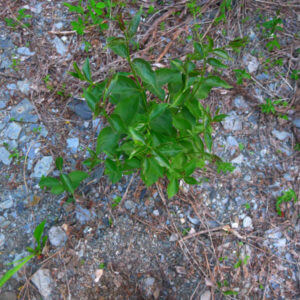Common Name: Black Swallowwort
Specific Name: Cynanchum louiseae
Known Occurrence at Taylor Point:
Map Areas: Beach 1C, Beach 1D, Woodland 3A, Woodland 3B, Woodland 3C, Woodland 3D, Bridge 4A, Bridge 4B
Category: Invasive, Non-Native Vine

Ecological Considerations: General:
Black Swallowwort is a perennial, twining herbaceous vine that can reach 6 ft in length. The leaves are oval shaped with pointed tips and occur in pairs along the stem. The small five-petaled star shaped flowers are dark purple to almost black with white hairs, and are borne in clusters. The fruits are slender tapered pods. Plants have rhizomes (underground stems) that sprout new plants and grow in clumps of several to many stems, forming extensive patches. Black Swallowwort thrives in a wide range of settings and is shade tolerant. Swallowwort primarily reproduces by seed. Plants initially grow slowly and do not reproduce for a number of years. Root crown fragments regenerate when damaged or broken.
Problems Posed by this Plant:
Black Swallowwort roots contain chemicals which are toxic to mammals, including livestock. When female monarchs lay eggs on Swallowwort the caterpillars die. Black Swallowwort plants produces biochemicals that influence negatively the growth, and survival of other organisms.
Native Species Affected by this Plant:
Factors Affording a Competitive Advantage to this Plant:
Black Swallowwort forms associations with beneficial arbuscular mycorrhizal fungi (AMF) in the soil that help to colonise the plant roots and aid in the uptake of soil nutrients. These associations are higher than in native species in the same area giving Black Swallowwort a distinct growth advantage. In addition large infestations of Black Swallowwort have four times as many of these fungi spores magnifying their advantage over native plants.
Propagation Mechanisms and Related Issues Affecting Efforts to Remove and/or Eliminate this Plant from Taylor Point:
Documented Best Removal Practices and Options/ Pros and Cons of Various Options:
Hand-pull seedlings and young plants. When pulling, vines will often break off at the surface, above the root collar, so this action is effectively a cut with little or no root extraction. But, repeated pulling throughout the growing season, perhaps five times or more, may significantly reduce the population by starving the roots and eliminating seed production.
Dig up mature plants being sure to get the crown from which the plant can re-sprout.
If you are unable to remove all plant material once the project has begun, absolutely be sure to cut off developing seed pods before the seed ripen ( July – August ) and remove them from the site and/or burn them.
Follow-up control of seedlings will most likely be required in subsequent years.
Small infestations of Black Swallowwort should be eradicated before they can benefit from the effects of a large stand of Black Swallowwort and before they begin to form seeds. Plants in full sun, which produce more seed should be given priority. Mechanical control in the form of digging is only effective for young plants where the entire root crown can be removed. Cutting and mowing stimulate sprouting from the root crown, resulting in denser infestations the following season however cutting should be used to remove flowers prior to seed formation.
No plants parts should be composted as they will re-sprout.
Case Studies of Removal Efforts, Lessons Learned and Recommendations:



Sources cited:
Michigan Department of Natural Resources
URI College of Environment and Life Sciences
Suzanne Enser, TPRA CRMC PermitRequest Support Document
Key Words:
Black Swallowwort
Cynanchum louiseae
arbuscular mycorrhizal fungi (AMF)
vine
rhizomes
root crown
seed pod
